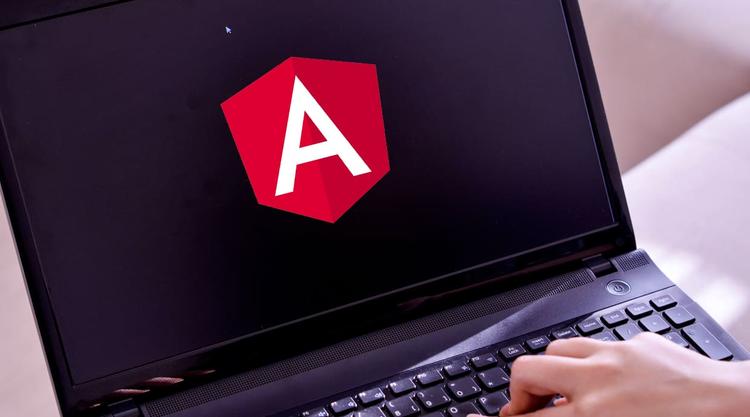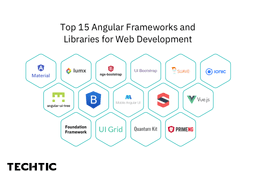Top 15 Angular Frameworks and Libraries for Web Development
Sector: Technology
Author: Nisarg Mehta
Date Published: 07/25/2022

Contents
As we approach 2022, web development is becoming increasingly complex. New frameworks are continuously emerging, and veteran frameworks are updating to meet new demands. With so many different options available to developers, it can be challenging to determine which framework is suitable for any given project.
In this article, we’ll discuss the top 12 Angular frameworks that will continue to dominate in 2022, as well as some smaller but promising up-and-comers.
Each of these frameworks has its own advantages and disadvantages; some may be more useful than others, depending on your specific needs and project requirements.
However, the choices you make now will have a lasting impact on your future projects and career trajectory as a software engineer.
Before we jump straight to the top Angular frameworks, let’s first understand what a framework is.
What is Angular Framework?
Angular.js is a framework for developing robust web apps. It enables developers to expand HTML’s syntax to create clear and concise application components using HTML as the template language. Dependency injection and data binding are among the Angular features that allow you to write significantly less code for increased functionality.
AngularJS makes it possible for developers to build web applications using HTML. You might already know that HTML is fantastic for building static web pages but not adequate for developing software applications; AngularJS solves this problem with its libraries and frameworks.
This is where it becomes crucial for you to pick the right Angular framework.
Top 15 Angular Frameworks and Libraries for Web App Development
Check out some of the most popular angular frameworks for web app development:

1. Angular Material
Angular Material, a CSS Framework endorsed by the Angular team, is one of the best Angular UI Frameworks. It is a UI component library with high-quality, reusable templates, admin panels, and components.
Angular Material is built on Google material design and includes more than 30 UI components for Angularjs applications, including inputs, date pickers, data labels, and cards.
Since Angular Material offers a rich CSS library with typography and similar components, it is very popular among developers across the globe.
With Angular Material, web developers can create attractive, engaging, fast, and responsive websites by ensuring that they follow contemporary design practices and principles such as device independence, browser portability, and graceful degradation.
Highlights
- Usages Google Material Design
- Reusable templates
- Includes UI components like inputs, date pickers, cards, and data labels
- Rich CSS library
- Browser portability
2. LumX
LumX is an Angular framework for front-end development that uses Google Material Design techniques to create visually appealing and user-friendly interfaces. This SaaS framework can be considered the best CSS framework for Angular. It can be used to customize the design of your web app.
Furthermore, it optimizes your JS files and SaaS with Gulp, thereby improving the performance of the app. jQuery can also be used with LumX without the need for any plugin.
Highlights
- Usages Google Material Design
- Supports jQuery
- Optimizes JS files and SaaS with Gulp
3. NGX-Bootstrap
NGX-Bootstrap is an open-source library for Angular that offers many useful features, such as buttons, alerts, pagination, tabs, progress bars, popovers, and more. These components make your web design job easier. They also help you customize the process to your needs.
Moreover, modal dialogs, dropdown menus, and tooltips, for example, are included in this library. These elements are suitable for keyboard, touchscreen, and mouse users.
Developers can select their preferred option when they build a web application. Although they don’t have to use individual JS components as drag-and-drop functionality, CSS and HTML components from Bootstrap can be used to create web applications. NGX-Bootstrap is continually being improved, and a new version is always available.
So, go for it.
Highlights
- Offers components such as buttons, alerts, pagination, progress bars, tabs, popovers, etc
- Supports drag-and-drop functionality, CSS and HTML
4. Angular UI Boostrap
Angular UI Boostrap is an AngularJS framework that uses Bootstrap as its foundation. As a result, Angular UI Boostrap is one of the finest front-end frameworks for software development.
Angular UI Boostrap is the answer for those who want to use Bootstrap with Angular. The reason is that you cannot directly use Bootstrap in an Angular project since it relies on jQuery, which may interfere with Angular’s specific functions.
On the brighter side, this framework is created on pure AngularJS directives based on CSS and Bootstrap HTML elements, so it does not require jQuery and can be used to integrate Bootstrap components in an Angular job.
Highlights
- Eliminates the need for jQuery
- Created on pure AngularJS directives
- Uses Bootstrap as its foundation
5. Suave UI
Suave UI helps developers create web UI interfaces on Angular. The most awesome thing about Suave UI is its wide range of directives, CSS definitions (like grids, layered elements, and colored buttons), and services, which allow developers to experiment with a variety of UI components.
Moreover, it stores UI components in bundle files, eliminating the need to include them individually. Developers don’t have to include these bundled component libraries separately, as they are already included. Hence, they can accomplish the task with just one browser command.
Highlights
- Offers components like grids, layered elements, and colored buttons
- Stores UI components in bundle files
6. Ionic
Ionic is one of the most well-known Angular frameworks that run on multiple platforms. Because it is open-source, Ionic is a hybrid mobile application development framework that uses web technologies like CSS, HTML5, and SASS.
Consequently, Ionic offers a front-end SDK based on Cordova and AngularJS that enables the production of hybrid mobile apps that work across several platforms, including iOS and Android.
The Ionic framework includes plenty of Angular components and directives, making it simple to produce AngularJS mobile applications.
Highlights
- Open-source
- Runs on multiple platforms
- Uses web technologies like CSS, HTML5, and SASS
- Offers a front-end SDK based on Cordova and AngularJS
- Includes plenty of Angular components and directives
7. Angular UI Grid
Angular UI Grid has given an entirely new viewpoint to database-driven web app development processes. The framework grid gives a variety of abilities, including visualization, e2e testing, filtering, grouping, user interaction, sorting, and many more.
This framework enables Angular.js to be used without jQuery in addition to the native Angular.js functionality. The plugin enables you to choose only the functionalities you need to minimize the time and effort required to build your website.
Customizing your website’s appearance with this library’s predefined components is a breeze as it allows you to convert the CSS files to use Angular UI Gird’s pre-configured components. With this framework, you can make your applications more appealing, which in turn will help you better target users’ wants and make more visitors return.
Highlights
- Offers native Angular.js functionality
- Allows you to convert CSS files to use pre-configured components
- Runs without jQuery
8. Angular UI Tree
Angular UI Tree is a popular Angular UI framework among developers used for sorting nested lists. Angular UI Tree does not require jQuery, making it simple for you to alter the items of a tree. In addition, angular UI Tree utilizes AngularJS’s native scope and prevents child nodes in components to ensure that data bindings work properly.
Although this framework solely is not adequate enough to build the entire front end of your web application, you can couple this with other Angular frameworks to speed up your web app UI development.
Highlights
- Used for sorting nested lists
- Does not require jQuery
- Utilizes AngularJS’s native scope and prevents child nodes
9. Radian
A JS library fronted by Angular, Radian is a straightforward, open-source library that enables developers to make embedded plots in HTML documents.
With Radian, developers don’t have to create JavaScript; instead, they can use HTML to represent plots. In addition, Radian plays a crucial role in binding the JavaScript variables and HTML elements. This JS library is primarily used for platforms that deal in Bayesian statistics.
Radian offers technologies that enable two-way data binding between HTML components and JavaScript variables in addition to D3.js for the graphic generation that allows the creation of SVG components. In addition, these components may be embedded directly on the page, which enables them to be accessed from any browser.
Another crucial component of Radian is that it offers comprehensive documentation backed with a liberal license that makes getting started with this particular Angular widget framework a breeze.
Lastly, this open-source library is versatile, and you can use it to accomplish different tasks related to web development projects.
Highlights
- Open-source Angular library
- Enables two-way data binding between HTML components and JavaScript variables
- Allows the creation of SVG components
- Offers comprehensive documentation backed with a liberal license
10. Mobile Angular UI
Mobile Angular UI is an open-source JS library mainly used for creating cross-platform hybrid mobile apps that are built on Angular JS.
While composing these applications, you can store your files in the cloud using the Angular file uploader for Image and File. This makes it easy for developers to access the files whenever they want to retrieve these uploaded files for the development phase.
You can also use this library to create navigation bars that display the header, footer, or menu bars. To speed up the process, a scrollable header, as well as a footer, are positioned for the footer and header.
Also, before you upload your pictures, you may resize them to fit the frame of your applications.
Highlights
- Dedicated cloud storage for images and files
- Helps create navigation bars that display the header, footer, or menu bars
11. Supersonic
Supersonic, an agnostic AngularJS UI framework that includes JavaScript, web-based components, and CSS, can be used with any popular framework. It is termed an agnostic framework.
It simplifies HTML apps and is cohesive with AngularJS. Supersonic works with AppGyver. However, just to be clear, most of the APIs will not operate on a mobile website or vanilla Cordova app.
With Supersonic, developers can transcribe HTML and CSS components, or they can utilize components that map HTML to native APIs and native interference with ease.
Highlights
- Helps transcribe HTML and CSS components
- Can be used with any popular framework
12. Quantum UI
With over 60 AngularJS-based front-end development components, Quantum UI streamlines the web development process by providing rest-service and server-friendly UI elements. It is built on an MVVM architecture and has Bootstrap-compatible CSS structure are included.
This Angular testing framework is maintained and hosted by GitHub. You don’t have to write JavaScript for Quantum UI; you can configure it using just properties and attributes. The majority of its elements are free and open-source, whereas others must be paid for.
Highlights
- Provides rest-service and server-friendly UI elements
- Built on an MVVM architecture
- Maintained and hosted by GitHub
13. Angular Foundation
Angular is one of the most popular frontend frameworks. It is a modified and updated foundation that relies on CSS elements and Foundation markup to create directives.
The greatest advantage of using this framework is that it allows for the creation of more semantically enriched websites. Examples include interchange, dropdown, alert, accordion, process bar, and trigger.
Highlights
- Relies on CSS elements and foundation markup to create directives
- Allows for the creation of more semantically enriched websites
- Components include interchange, dropdown, alert, accordion, process bar, and trigger
14. PrimeNG
Creating the front-end of complex apps using this game-changing JavaScript Angular framework’s declarative UI style is a breeze. With over 70 UI components to choose from, PrimeNG provides you with everything you need. Likewise, angular has everything you need, from native themes to pre-built widgets, if you’re working on an Angular project.
With regards to front-end development, PrimeNG is one of the best frameworks out there. It allows you to include a wide range of front-end features in your web application, such as charts, form inputs, overlays, menus, and more. In addition, its MIT license allows you to use the MIT open-source widgets for free and open-source.
Highlights
- Comes with an MIT license
- Offers 70+ UI components, including themes and pre-built widgets
- Facilitates front-end features such as charts, form inputs, overlays, menus, and more
15. Vue.js
Vue.js is an open-source Angular framework that allows users to build web app UIs and single-page applications. Routing, state management, and build tooling functionalities are all part of Vue.js’s most highlighted feature list. Its features also include an adaptable architecture for declarative rendering as well as component composition.
Vue has become broadly utilized in many sectors since its initial release in August 2021. Its prior versions have been upgraded, and the app is used in the development of numerous web applications. Using this framework is simple, and you can customize it to suit your web development project.
Highlights
- Offers routing, state management, and build tooling functionalities
- Adaptable architecture for declarative rendering
- Customizable for web development
Which Angular Frameworks Should You Use?
The Angular UI frameworks that we’ve discussed in this article are our favorite dynamic web app development frameworks because of their flexibility and features. As each Angular framework has its own advantages and disadvantages, you should pick one or more according to your project and web app UI needs.



